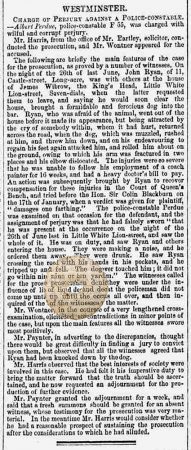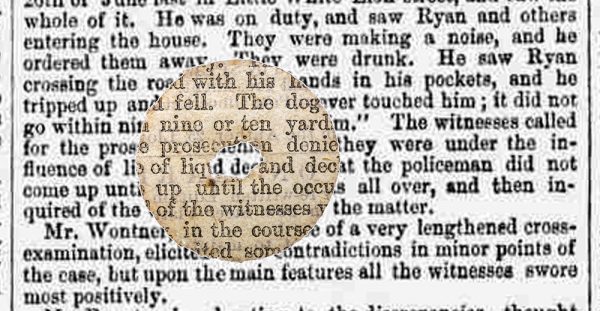It’s interesting that through all my research I haven’t found one exact match to the newsprint on a washer. I’m curious to know why this is whether it’s because of those stories have come from newspapers that were never kept in the British library and have disappeared from history. Or whether there were many print runs and they were all slightly different.
It seems that the paper used for newspapers back in 1861 was woodpulp but, as would be evident in some of the close-up images I have created, there are certainly bits of coloured cloth, be it cotton or linen, within the paper pulp. Nick Wyatt, from the science museum was convinced that paper pulp used in newspaper production back then would have been recycled in a very messy way using old newspapers woodpulp and bits of various other things including rag.
From an email to my client dated Oct 15th 2019
 From early October 2019 I became increasingly obsessed with finding the source of the newspaper washers. I was starting to find the stories from The British Newspaper Archive website, but the big puzzle for me was that some of the wording was different to the washers and when I found a close match where all the words matched there was always a slight mismatch of the print. But more than this, the online search enabled me to see all the pages of any specific newspaper and so I could surmise what the reverse of a washer should have on it, or what it should not. However, the closest, imperfect match for a single washer was from the Morning Chronicle of Thursday, 7th of February 1861 shown to the left with the washer printed to scale on top.
From early October 2019 I became increasingly obsessed with finding the source of the newspaper washers. I was starting to find the stories from The British Newspaper Archive website, but the big puzzle for me was that some of the wording was different to the washers and when I found a close match where all the words matched there was always a slight mismatch of the print. But more than this, the online search enabled me to see all the pages of any specific newspaper and so I could surmise what the reverse of a washer should have on it, or what it should not. However, the closest, imperfect match for a single washer was from the Morning Chronicle of Thursday, 7th of February 1861 shown to the left with the washer printed to scale on top.
I took a trip to London in search for some answers. First stop was the British Library where I was hoping to find a greater range of archive newspapers than they had in their website archive. And this was the first question, that I asked at the Newspapers reception desk. Unfortunately, the answer given did not help me, I was told that most of their physical newspapers were held off site and anyway most had been digitalised and were on the British newspaper archive which I already had access to. I was pointed to a list of all of the newspapers that were in print during the 1860’s and I was welcome to search through the microfilm of those that had not yet been digitised. I set about this task but after an hour of finding no references I put that on hold. Another question I had was regarding the printing process back in the 1860s, was it possible that the individual letters set in the press could move (through vibrations etc) to a detectable degree in that the printed text on the washer would not match that from the archive copy of a newspaper? And what was newspaper pulp made from? A librarian showed me a section of books that related to the history of the printing press and with reference to newspaper printing in the second half of the 19th century, picking a couple of them out for my research. These were scanned through picking out specific chapters relating to my question and copying those pages using Microsoft Office Lens, that I had installed on my phone. This would enable me to read it through again later, just in case there was anything that I had missed. Again, I had no answers to my questions.
I headed across town to Exhibition Road, choosing to walk rather than taking a bus or tube because there was a long train journey still to be taken at the end of the day. As I approached Kensington, heading towards the V&A I was caught in a torrential cloudburst and hurriedly ran into The Science Museum, thinking that they might have some answers about printing presses. I was a little taken back by the enthusiasm to help that I received from a lady at the enquires desk. There was no exhibition of printing presses and no display of the printing process, but her mission was to find an answer for me and phoned up the head librarian at the dedicated Science Museum library. I was summoned straight away to go over to the library that was just around the block but would take around 10 minutes to walk. The rain eased and I set off only to find the heavens open once more. I arrived at the library soaking wet but welcomed in as if I were a VIP. The Librarian, Nick Wyatt, was able to identify the washers as ‘balance washers’ for pianos and that they can be bought commercially now, referring to a website with similar washers as the ‘plain’ paper washers from the Erard Grand. But he couldn’t find out whether they were commercially made or handmade in the 1860s. Nick Wyatt suggested that perhaps the Erard factory simply ran out of balance washers on the day that the keys were to be levelled and so rather than wait for another delivery made their own from whatever paper card and board they had lying about. It could also be that very thin washers were needed for fine balancing and so again they were made in the factory. Doing a Google search for newspaper piano balance washers we came across the following blog: http://cazzbo.blogspot.com/2016/09/punchings.html This was fascinating because it described with illustrations another example of an old piano with balance washers cut from newspapers.
 Close-up of the mis-matched washer.
Close-up of the mis-matched washer.
It seems like I had spent a lot of research time travelling many corridors but finding that they all lead to dead ends. Every door that was open shut down as I approached it. Surely when one door closes another one opens for you? Then I had a lightbulb moment which I relayed to my client on October 18th 2019:
My research skills maybe aren’t so great as it just dawned on me that the British newspaper archive doesn’t include The Times, The Telegraph or The Guardian. It wouldn’t surprise me at all if an exact match of the paper washers’ text can be found in one of these newspapers. At least I’ve pinned down the day, or couple of days that the stories would have been printed. The plot thickens…